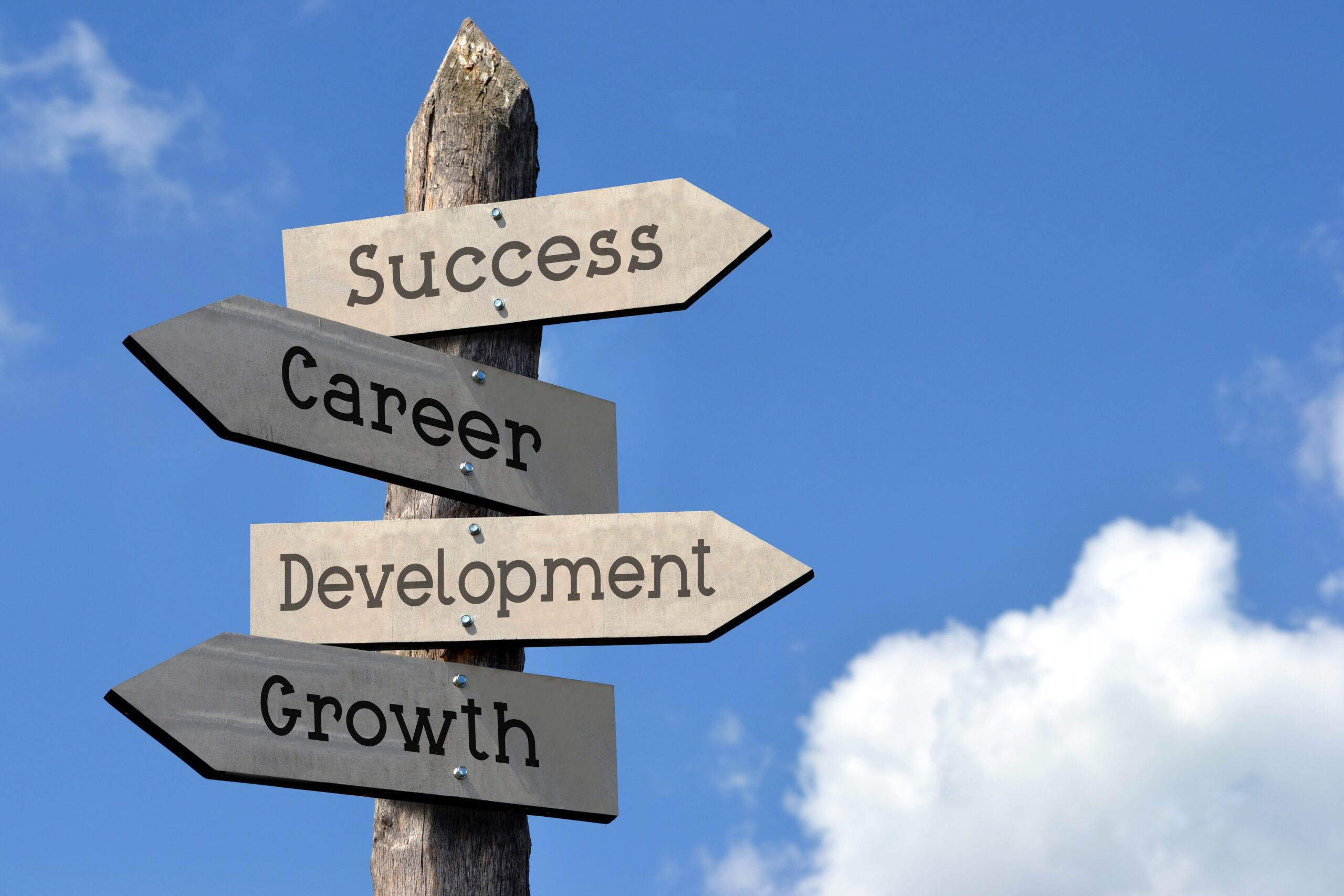Thriving organizations understand that success starts with their people. When employees are given the tools and opportunities to grow professionally, they don’t just perform better—they become more engaged and loyal to the company. Career growth and development isn’t just about promotions; it’s about creating an environment where individuals feel valued, supported, and empowered to reach their full potential.
So, why is career development so important? It bridges the gap between employee aspirations and organizational goals, fostering a culture of mutual success. With initiatives like career development programs for employees, companies can cultivate a highly skilled and motivated workforce that drives innovation and growth. In this blog, we’ll explore how prioritizing career development can elevate both individuals and organizations, ensuring long-term success for all.
Understanding Career Growth and Development
Career growth and development go beyond the traditional notion of climbing the corporate ladder. They encompass a holistic approach to advancing one’s career through learning, skill-building, and gaining meaningful experiences. While career growth focuses on the long-term trajectory of an individual’s professional life, career development involves the short-term actions and opportunities that build toward that future, such as training, mentorship, and new responsibilities.
For organizations, career growth and development are not just employee benefits—they are strategic investments. Employees who feel their potential is being nurtured are more likely to be engaged and aligned with the company’s vision. Whether it’s upskilling through certifications, transitioning into leadership roles, or simply mastering new technologies, career development helps employees contribute more effectively to organizational success.
The Benefits of Career Development Programs for Employees
Career development programs for employees are more than just an organizational perk; they are a cornerstone of fostering a skilled and motivated workforce. These programs provide structured opportunities for employees to enhance their abilities, gain new insights, and advance in their careers. When organizations invest in these initiatives, they create a culture of growth and learning that benefits both employees and the company as a whole.
1. Enhanced Skill Development
Career development programs ensure employees acquire the skills needed to meet current and future job demands. From technical training to leadership workshops, these initiatives prepare employees to take on new challenges with confidence and competence, directly contributing to organizational success.
2. Increased Employee Satisfaction and Loyalty
Employees who feel their growth is prioritized are more likely to stay loyal to their organization. Career development programs show a commitment to their future, boosting morale and reducing turnover rates.
3. Internal Mobility and Talent Retention
By cultivating talent internally, organizations can fill critical roles without the need for costly external hiring. Employees who participate in development programs are better equipped for promotions, ensuring a seamless transition into leadership or specialized roles.
4. Improved Organizational Performance
A workforce that is continually learning and developing is more innovative, productive, and adaptable. Employees bring fresh ideas and best practices gained through development programs, driving overall business performance.
By implementing career development programs, organizations not only invest in their employees’ futures but also strengthen their ability to compete and thrive in a dynamic business environment. It’s a win-win strategy that positions both the individual and the company for success.
Why Is Career Development Important for Organizational Success?
The question of why is career development important is one every forward-thinking organization should ask. At its core, career development is about more than just helping employees achieve their personal goals—it’s a strategic approach to building a stronger, more resilient organization. By prioritizing the growth of their workforce, companies can unlock a range of benefits that drive long-term success.
1. Aligning Employee Goals with Organizational Objectives
Career development bridges the gap between individual aspirations and business needs. When employees see a clear pathway for advancement that aligns with their personal goals, they are more motivated to contribute their best work. This alignment fosters a shared sense of purpose, driving both individual and organizational success.
2. Enhancing Workforce Adaptability
In today’s fast-changing business environment, staying competitive means having a team that’s ready to evolve. Career development ensures employees are equipped with the latest skills and knowledge, enabling organizations to adapt quickly to market trends and challenges.
3. Attracting and Retaining Top Talent
Organizations that invest in career development are seen as desirable places to work. Employees are more likely to stay with companies that prioritize their growth, while potential hires are drawn to opportunities for advancement. This reduces turnover costs and ensures a steady pipeline of talent.
4. Driving Innovation and Productivity
Employees who are continuously learning are more engaged and innovative. Career development programs encourage creative problem-solving and improved performance, which directly impacts the company’s bottom line.
5. Strengthening Leadership Pipelines
Effective career development initiatives identify and prepare future leaders within the organization. By grooming internal talent for leadership roles, companies can ensure smooth transitions and maintain continuity in their operations.
By fostering career development, organizations create an environment where employees thrive, innovation flourishes, and business goals are consistently met. It’s not just a matter of supporting employees—it’s about building a foundation for sustained organizational success.
Measuring the Impact of Career Growth Initiatives
For organizations to understand the effectiveness of their career growth and development efforts, it’s crucial to measure the outcomes. Tracking the impact of these initiatives not only demonstrates their value but also highlights areas for improvement. By leveraging specific metrics and feedback, companies can ensure their career growth programs contribute meaningfully to both individual and organizational success.
1. Employee Retention Rates
High retention rates are often a direct result of effective career growth initiatives. When employees see opportunities for advancement and feel supported in their professional journeys, they are more likely to stay with the organization. Tracking turnover rates and exit interview data can help assess the impact of these programs.
2. Employee Engagement Scores
Career development initiatives play a key role in boosting employee engagement. Regularly measuring engagement through surveys, feedback, and performance evaluations can reveal how career growth efforts influence employees’ motivation and satisfaction.
3. Internal Promotions and Role Mobility
Monitoring the number of internal promotions and lateral moves is another way to measure success. A high rate of internal advancement indicates that employees are gaining the skills and experience needed to take on new challenges within the organization.
4. Training Completion Rates and Outcomes
The effectiveness of career development programs can be evaluated by tracking participation and completion rates. Additionally, assessing the outcomes—such as improved skills, certifications earned, or performance improvements—provides valuable insights into their impact.
5. Productivity and Performance Metrics
Employees who engage in career growth programs often demonstrate improved productivity and performance. Metrics such as project success rates, sales numbers, or client satisfaction can be used to quantify the benefits of these initiatives.
6. Employee Feedback and Satisfaction Surveys
Direct feedback from employees provides qualitative insights into the success of career growth initiatives. Regular surveys and open forums encourage employees to share their experiences, offering a clearer picture of what’s working and what needs adjustment.
7. Return on Investment (ROI)
Measuring the ROI of career development programs involves comparing the costs of these initiatives with the tangible benefits they generate, such as increased productivity, reduced hiring costs, and improved employee retention.
By using these metrics, organizations can ensure their career growth initiatives are aligned with their goals, continuously refined, and ultimately effective in driving both employee and organizational success.
Overcoming Challenges in Career Development
Implementing effective career growth and development programs is essential for organizational success, but it doesn’t come without challenges. From resource constraints to resistance to change, organizations must proactively address these obstacles to ensure their initiatives are impactful and sustainable. Here’s how to navigate the most common challenges in career development:
1. Limited Resources and Budget Constraints
Smaller organizations or those with tight budgets may struggle to allocate sufficient funds for robust career development programs. To overcome this, businesses can explore cost-effective alternatives like online training platforms, internal mentoring programs, or peer-led workshops. Leveraging existing resources creatively can still provide valuable growth opportunities.
2. Resistance to Change
Employees or leaders may resist career development initiatives due to fear of change or skepticism about their benefits. Open communication is key to addressing these concerns. Highlighting success stories, explaining the long-term value of career development, and actively involving employees in the program’s design can foster buy-in and enthusiasm.
3. Balancing Development with Job Responsibilities
Employees may feel overwhelmed if career development activities interfere with their day-to-day responsibilities. Organizations can address this by integrating learning into the work routine, such as on-the-job training or flexible learning schedules, ensuring employees can grow without compromising productivity.
4. Lack of Clear Career Paths
Employees can become disengaged if they don’t see a clear trajectory for their growth within the company. To resolve this, organizations should map out transparent career paths and regularly communicate opportunities for advancement. Personalized development plans aligned with individual goals and organizational needs can also provide clarity.
5. Unequal Access to Opportunities
Some employees may feel left out if development initiatives are not equitably distributed. Organizations should ensure programs are inclusive and accessible to all, regardless of role, department, or seniority. Diversity-focused initiatives can also help address any gaps in representation.
6. Measuring Program Effectiveness
Without clear metrics, it can be difficult to determine whether career development efforts are successful. Establishing key performance indicators (KPIs), such as engagement rates, retention, and skill acquisition, provides actionable data to refine and improve initiatives.
7. Rapid Industry Changes
As industries evolve, outdated training programs can hinder employee growth. Organizations should stay agile by regularly updating their development programs to align with new trends, technologies, and market demands.
By identifying and addressing these challenges head-on, organizations can create career development initiatives that are not only effective but also adaptable to the evolving needs of their workforce. This proactive approach ensures that career growth remains a cornerstone of long-term organizational success.
Prioritize Career Growth for Lasting Success
Investing in career growth and development is one of the most effective strategies for driving organizational success. By fostering a culture of continuous learning, offering tailored career development programs for employees, and aligning individual aspirations with business objectives, companies can build a workforce that’s skilled, engaged, and committed to excellence.
At Maverick Marketing, we understand the transformative power of professional growth—not just for individuals but for the organizations they drive forward. Our commitment to empowering employees through innovative training and mentorship ensures that our team members are equipped to deliver exceptional results for our clients. If you’re ready to join a company that values your career development and aligns your growth with success, Maverick Marketing is the place for you.







